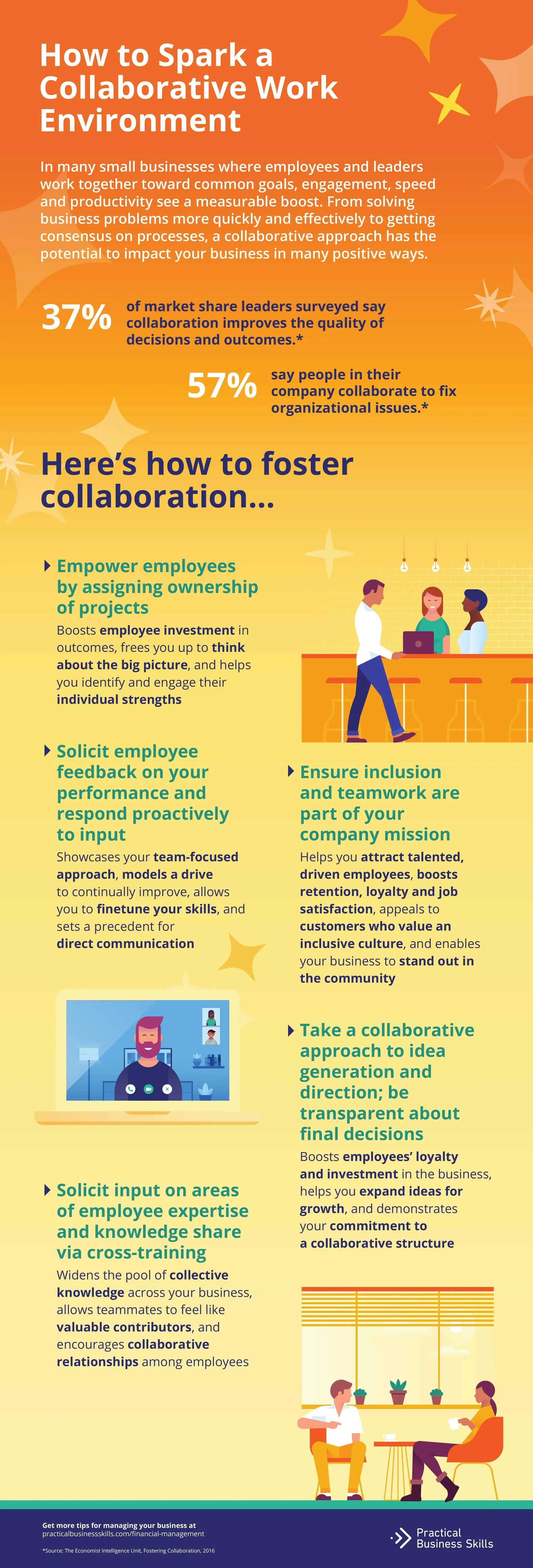Collaboration is one of today’s most misunderstood workplace concepts. Many businesses claim to have a collaborative culture, but few create the conditions where it truly thrives. Too often, collaboration is mistaken for endless meetings, consensus-driven decisions, or simply asking for feedback. In reality, a collaborative work environment is about something deeper: a shared commitment to solving problems, improving outcomes, and moving the business forward… together.
57% say people in their company collaborate to fix organizational issues. 37% of market share leaders surveyed say collaboration improves the quality of decisions and outcomes.
Practical Business Skills
In startups and small businesses, especially those with limited resources and employees wearing multiple hats, effective collaboration can deliver a measurable boost in engagement, productivity, and innovation.
These insights point to an important truth: collaboration is not about groupthink or collective decision paralysis. It is about enabling employees to bring their unique strengths to the table, while maintaining clear leadership and direction. Business owners and leaders who understand this distinction are far more likely to see collaboration improve the speed, quality, and impact of their organization’s work.
What Collaboration Is — And Is Not
First, it is crucial to dispel one of the most common myths in the workplace today: collaboration is not equivalent to team-based decision-making. It is not about putting every decision to a vote or requiring complete consensus before moving forward. Nor is it leadership by committee or decision-making through endless rounds of feedback.
True Collaboration Is:
- Encouraging the open and respectful sharing of ideas and expertise.
- Structuring projects so individuals take ownership of outcomes.
- Empowering employees to contribute in ways that leverage their strengths.
- Ensuring transparency around how decisions are made — even when leadership retains final accountability.
- Creating a culture where feedback is valued and acted upon.
Collaboration Is Not:
- Endless, unfocused meetings that waste time and energy.
- A requirement for consensus on every issue.
- A lack of accountability or direction.
When done well, collaboration accelerates business outcomes rather than hindering them. It energizes employees rather than exhausting them. It strengthens leadership rather than undermining it.
How to Foster Effective Collaboration
Creating a collaborative work environment requires intentional leadership and clear practices. It is not something that happens by accident. The following are proven ways leaders can encourage and sustain meaningful collaboration across their teams:
- Assign ownership of projects. One of the most effective ways to encourage collaboration is to assign clear ownership of specific projects or initiatives. When employees know they are responsible for outcomes, they are more invested and engaged.
- Solicit and respond to feedback. Collaboration is built on trust, and trust grows when leaders actively seek feedback and respond to it. Regularly soliciting input on processes, performance, and leadership style demonstrates that feedback is welcome and has a genuine impact.
- Encourage cross-training and knowledge sharing. Cross-training programs and informal knowledge-sharing opportunities can break down silos and broaden the skills of your team. When employees feel like valuable contributors and learn from each other, collaboration strengthens naturally.
- Integrate collaboration into your mission and values. Employees are more likely to embrace collaboration when it is reinforced by the company’s mission, values, and culture. Making collaboration and inclusion part of your core identity attracts the right talent and fosters long-term loyalty.
- Be transparent about decision-making. While not every employee can or should make final decisions, transparency around how decisions are reached fosters trust. When employees understand how ideas are considered and how decisions are made, they are more willing to contribute their best thinking.
The Business Case for Collaboration
The ultimate goal of fostering collaboration is not to check a box or sound progressive — it is to improve the results of your business. Leaders who master this skill set build organizations that solve problems faster, adapt to change more effectively, and bring out the best in their people.
These outcomes can make the difference between an organization that struggles with slow processes and mediocre results and one that continually learns, improves, and grows.
By understanding what collaboration is — and what it is not — and by implementing the right leadership practices, business owners can create a work environment where collaboration is not just a buzzword, but a genuine driver of success.
